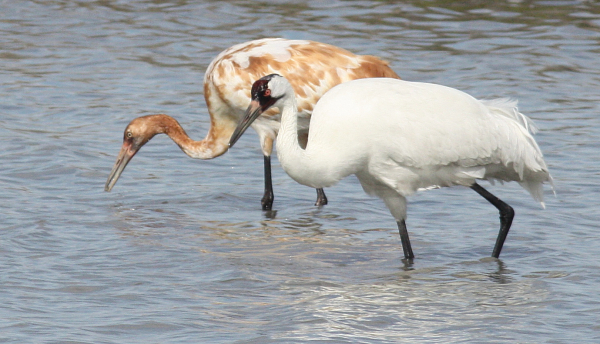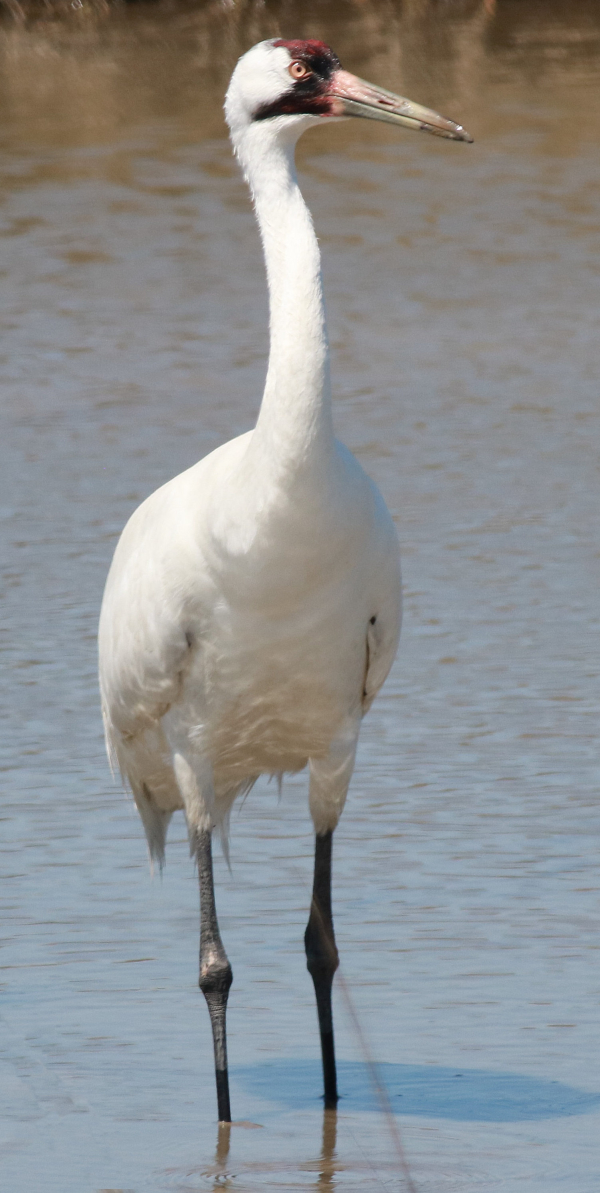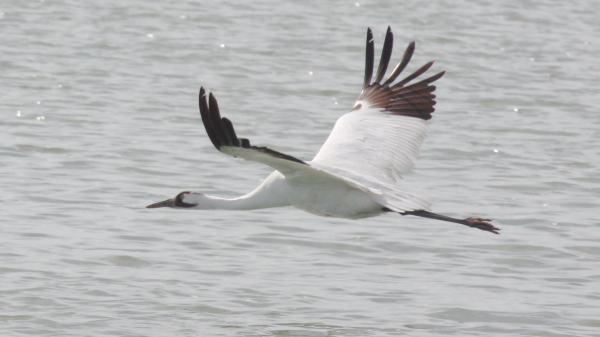The chance to see a super-rare family group of Whooping Cranes near my hometown of Bismarck was pretty thrilling! So much so that I alerted a long list of friends, family, and associates about my good fortune. Of course, knowing me and my interest and successes in photographing wild animals, a few asked where the photos were. They figure if I see it, I photograph it, and considering that my messages from the field are usually illustrated with vivid photos, their photo requests weren't unexpected.

I hated to admit that my photos were limited to documentary white dots in a distant landscape, but migrating Whooping Cranes are famous for being especially wary, picking out remote stopover locations in the midst of huge open marshes or expansive agricultural fields where they can see for a mile or more in each direction. I knew what to expect, and I was thrilled to have the rare family of cranes to myself on an almost windless blue sky fall afternoon, photos or not.
I’ve had a chance to see Whooping Cranes during migration stopovers 5 times to date, and only 2 have yielded photos beyond the white dot documentary stage. Even those 2 opportunities, in Saskatchewan and South Dakota, yielded pretty long-range photos. However, there is a place and a means to photograph Whoopers at fairly close quarters: You can observe and photograph wintering Whooping Cranes along the Gulf Coast of Texas, where some become surprisingly habituated to boat traffic adjacent to the coastal marshes where they forage during winters.

I have taken 3 Whooping Crane photo cruises to date, and each one was successful and memorable, and left me wanting more. My most recent Whooper cruise was in March 2021, about 20 months ago with Whooping Crane and Coastal Birding Tours in Rockport, Texas. Aboard the Skimmer, operated by Captain Tommy, I shared the opportunity to cruise into some of the Whoopers’ prime wintering range along the coastal wetlands of Aransas Refuge with 32 other enthusiastic birders, wildlife enthusiasts, and families with very interested children – what fun! We all shared excellent sightings and photo opportunities with 2 separate pairs of Whooping Cranes as they searched for blue crabs and other foods in shallow wetlands within low coastal islands.
I don’t know of any other way to get close to Whooping Cranes, which are super-wary during other times of the year. But that sunny morning both the pairs we stopped to photograph actually foraged closer to the boat after being little more than specks of white in the distance when we stopped. The second pair was really accommodating, and seemingly unconcerned by the double-decker boat “parked” on the island shore. Overall, we observed 15 Whoopers, a small percentage of the more than 500 Whoopers in this original population that migrates from their nesting range in and near Wood Buffalo National Park along the border of Alberta and Northwest Territories into the Great Plains and south to Texas.

Whooper Photo Techniques
While photographing from the ship, the best vantage point to photograph was the open second story deck. The added elevation provided a better view with the cranes positioned a few hundred feet away. The elevation also worked in our favor because the sun was a bit higher in the sky than is optimum. As for the sun, Captain Tommy was well aware of the importance of positioning the ship so we were between the sun and the cranes, with the sunlight beaming from behind us to illuminate the birds in the best possible way.
The other thing about the sunlight is that you will always get much better photo quality if you can photograph during morning or afternoon sunlight. But along the Texas Coast, sunlight can be a fleeting or non-existent entity too often, so you will want to plan your Whooper cruise during a sunny period, which means watching the weather forecasts for days and even weeks in advance. That’s what I did, and I timed my trip south from Dakota to Rockport so I would arrive the evening before the sunny Saturday morning that yielded sunshine, Whooping Cranes, and memorable photos of the super-rare birds.

Although this image of the tallest bird in North America shows some underside shadowing, the neck and face are highlighted well in true colors. What a thrill to be so close to such a rare and elusive bird, and to take photographs of it that show a high degree of detail.
|
Once in position, with the sun at your back and the cranes before you, it’s mostly a matter of following their movements and photographing them in different positions as they walk, wade, hunt, and probe below the water’s surface. Be ready for anything; the cranes could break out in a dance – seriously, cranes are famous for their animated dances – or one might catch a crab or another item, or even take flight.
With plenty of sunlight, I used my usual camera settings of ISO 400 and an aperture of f-8. With my Mode setting at Aperture Priority (Av), which automatically balances the aperture selected with the corresponding shutter speed, which tended to be between 1/1250 and 1/2000 of a second. The aperture setting provided a fairly wide area in focus and the shutter speed was fast enough to stop action – in case some action broke out. As it turned out, the adult pairs of Whoopers weren’t particularly active that morning, but they were very accommodating to provide quality photo opportunities in fairly close proximity.
During a similar 2011 3-hour cruise from Rockport, I appreciated similar sunny weather, and we spent time with a couple family groups that included 2 adults with their first-year juvenile. It was rewarding to photograph a young Whooper feeding with an adult to show the differences in their plumage, and I was also able to photograph an adult in low flight above water. Whooping Cranes are the tallest birds in North America, standing about 5 feet, and they have a broad wingspan of about 7 feet, but it’s hard to appreciate that when the birds are white specks in the distance – ha.
My best chance of photographing Whoopers during migration came in central Saskatchewan, north of Saskatoon where the prairie-parkland habitat meets the boreal forest. There, an associate and I followed a sighting tip that led us to a group of 7 Whooping Cranes on the edge of a shallow marsh – the migration stopover site for this band of immature Whoopers migrating south together. It was touch and go as we approached the wetland on a nearby road, but after stopping the vehicle the cranes showed little sign of concern, allowing me to photograph them as they rested, drank, waded in the shallows, and then it happened! They stretched their necks forward in characteristic crane pre-flight behavior, which alerted me immediately; and suddenly the flock spread their wings and took a few running steps to take flight generally in our direction! Wooo!
In flight, you photograph Whooping Cranes in just the same ways as other large flying birds, but with your heart beating much faster. You hold your breath, activate the auto-focus on one of the birds, and take as many photos as you can as the biggest birds in Canada fly across your field of view. Then you yell wildly for a few moments after they pass and before you regain your composure to watch where they were headed. This grand flock of regal white cranes didn’t go far, only to a harvested ag field where they would feed for the next segment of the day, preparing for the next leg of their migration – possibly to the Missouri River Valley or Missouri Coteau of North Dakota.

There is a bit more information about my background with cranes worldwide and about last week’s Whooping Crane observations in the river valley south of Bismarck in my Editor Afield article in this issue. And to learn more about Whooping Crane and Coastal Birding Tours, which I highly recommend, see Whooping Crane & Coastal Birding Tour | Rockport Birding and Kayak Adventures (whoopingcranetour.com) They are already booking for mid-November tours and beyond, and if you make the trip, maybe you will see the family group I observed near Bismarck along the Texas Gulf Coast. And maybe I’ll see them there too. Enjoy this first week of November and the birds that migrate into your view.
Article and photographs by Paul Konrad
Share your bird photos and birding experiences at editorstbw2@gmail.com